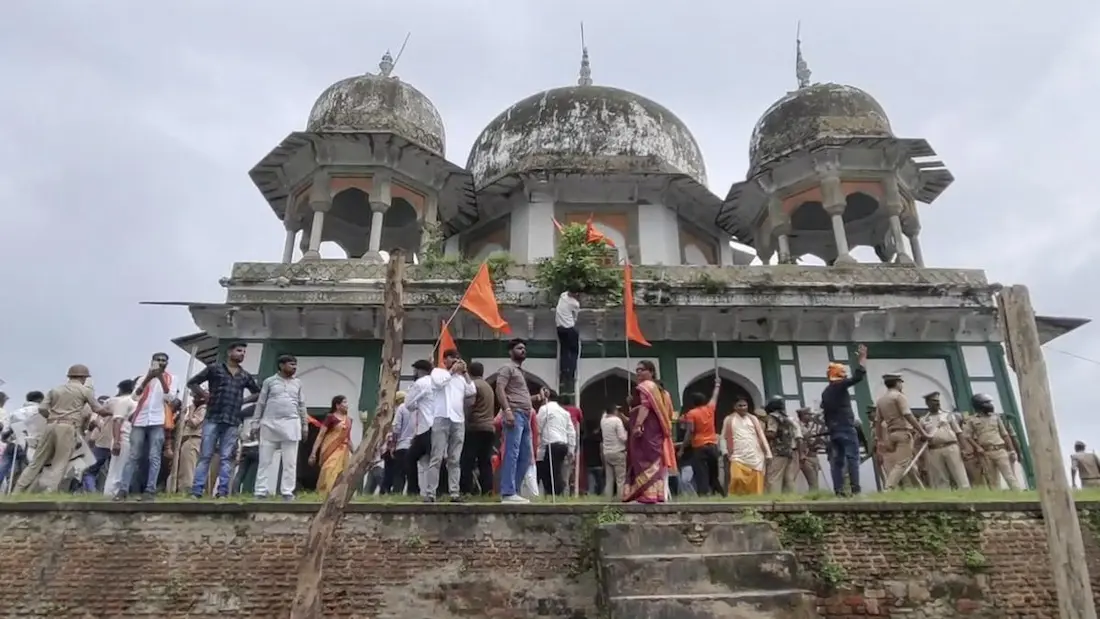
As claims of the tomb’s Hindu origins clash with its Islamic heritage, courts are tasked with navigating historical evidence
Fatehpur Tomb Controversy- In the heart of Uttar Pradesh’s Fatehpur district, a centuries-old tomb has become the epicentre of a storm, one that threatens to unravel the delicate threads of communal harmony. On August 11, 2025, a mob affiliated with a Hindu organization vandalized the tomb of Nawab Abdus Samad, claiming it was built atop a temple dedicated to Lord Shiva and Thakur Ji. The incident has sparked outrage, fear, and a renewed debate over history, identity, and politics.
Table of Contents
The Incident: Faith Meets Fury
The controversy began when the district president of the Bharatiya Janata Party (BJP) alleged that the tomb was not a mausoleum but a temple altered over time. He cited the presence of a lotus motif and a trident within the structure as “evidence” of its Hindu origins.
Soon after, members of a Hindu group stormed the site, vandalizing the area outside the mausoleum and announcing plans to perform a pooja. Stone-pelting and slogans followed, prompting the administration to deploy heavy police and PAC forces, erect barricades, and seal off the site.
Official records list the disputed land, Khasra number 753, as “National Property Maqbara Mangi,” a protected monument. Yet, the mob’s actions have ignited a volatile mix of religious fervour and political opportunism.
Historical Claims vs Legal Realities
This isn’t the first time a religious structure has been caught in the crosshairs of identity politics. The Babri Masjid-Ram Janmabhoomi dispute set a precedent for how historical ambiguities can be weaponized.
Key Points of Contention:
- Hindu Claim: The tomb is allegedly built over a 1,000-year-old temple. Symbols like the lotus and trident are cited as proof.
- Muslim Community’s Stand: Locals maintain the site is a graveyard, tended by the family of Naseem Baba until his death four years ago.
- Government Records: The site is listed as a protected national monument, with no official recognition of temple origins.
The administration has so far refrained from taking sides, emphasizing law and order over historical adjudication. Drone surveillance and legal action against vandals have been initiated.
The Politics of Sacred Spaces
The incident has triggered political sparring. Samajwadi Party leader IP Singh accused the BJP of “fanning the fires of communal unrest,” warning that such provocations could lead to riots.
This pattern, where religious claims are amplified by political actors, raises troubling questions:
- Are sacred sites being used as tools for electoral mobilization?
- Is historical revisionism becoming a strategy for cultural dominance?
- Can legal frameworks withstand the pressure of populist narratives?
India’s pluralistic ethos is built on coexistence. But when faith becomes a flashpoint, the consequences ripple far beyond the disputed site.
The Path Forward: Dialogue, Documentation, and Dignity
To prevent future flare-ups, India must adopt a multi-pronged approach:
1. Transparent Historical Audits
- Form independent archaeological panels to assess disputed sites.
- Publish findings publicly to counter misinformation.
2. Legal Clarity and Enforcement
- Update land records and monument registries with clear designations.
- Enforce strict penalties for vandalism and incitement.
3. Community Engagement
- Foster interfaith dialogues at the local level.
- Involve religious leaders in peacebuilding efforts.
4. Media Responsibility
- Discourage sensationalism and communal framing.
- Promote fact-based reporting and historical literacy.
The Fatehpur tomb controversy is not just about bricks and mortar, it’s about the soul of a nation grappling with its past and future. Whether India chooses reconciliation or retaliation will define its legacy for generations to come.
Judiciary at the Crossroads: The Court’s Pivotal Role
In the Fatehpur tomb controversy, the judiciary emerges as a crucial arbiter amid rising communal tensions. As claims of the tomb’s Hindu origins clash with its Islamic heritage, courts are tasked with navigating historical evidence, religious sentiments, and constitutional principles. Their rulings not only determine the fate of the monument but also set precedents for how India reconciles its layered past with its pluralistic present. In such volatile cases, judicial impartiality becomes both a shield against mob justice and a litmus test for democratic resilience.